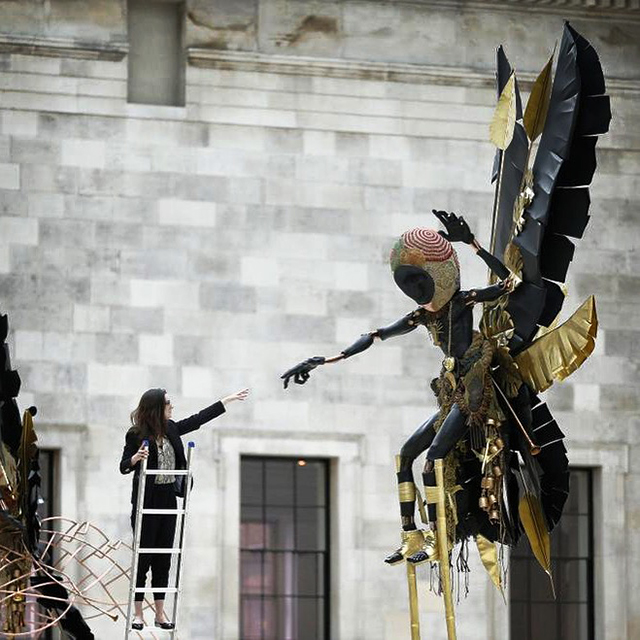Writing
Selected Writing
A collection of featured articles I've written for art publications.
African Art at the 2017 Venice Biennale
July 2017
This year's edition of the Venice Biennale was a momentous one for the African art scene with an impressive range of artists presented. Ten countries exhibited over 27 artists with works of sculpture, installations, paintings, film and performance. Sharon Obuobi shares her highlights of the best African art on display at the Biennale.
From a Wedding Dress to a Dagger, Examining the Gifts Countries Give Each Other
March 4, 2016
The 2016 Armory Show is in full swing, and this year’s Focus section offers an insightful look at contemporary African art. In alignment with the focus on contemporary African art, fair organizers appointed Kapwani Kiwanga as this year’s Armory Artist Commission.
Unpacking the Gift: Armory Commissioned Artist Kapwani Kiwanga in Conversation
March 2016
Visitors to The Armory Show this week will notice the image of a bouquet of yellow flowers stacked and repeated on catalogue covers throughout the fair. The golden, tasselled bouquet is more than a decorative flourish: it’s the work of Kapwani Kiwanga, from her ongoing series Flowers for Africa...
Zina Saro-Wiwa on Art and Authentic Storytelling in the Niger Delta
December 2015
Zina Saro-Wiwa is a British-Nigerian artist and filmmaker whose body of work includes video installations, experimental films, and documentaries. Zina Saro-Wiwa spoke with me about her process in developing new work, the gallery she founded in Port Harcourt, and the importance of art on the Niger Delta region.
Telling Time in Bamako: Curator Bisi Silva on the Anniversary Edition of the African Biennale of Photography
December 2015
Over its 20-year history the biennale has played a role in the increased visibility of African artists... I spoke with Artistic Director Bisi Silva, Director of the Centre for Contemporary Art (CCA), Lagos, about the direction she took Bamako Encounters’ anniversary edition, Telling Time.
British Museum’s First Commissioned Caribbean Sculptures Tower Over Its Great Court
September 2015
Wander into the British Museum’s Great Court these days, and you’ll encounter two large, black and gold Moko Jumbie sculptures guarding the staircases on either side. Balancing on seven-meter high (approx. 23 feet) golden stilts, these dark figures resemble wasps with outstretched, upright eagle wings.
Egypt's Dynamic Street Art and Graffiti Culture: The Walls Must Still Speak
September 2013
Two years after Egypt experienced a much internationally publicized political uprising, the country is still experiencing the aftermath since the upheaval of former President Hosni Mubarak's regime. While these dramatic changes have been at the forefront of media attention, a different yet parallel movement has been taking places on the streets. Artists have adopted graffiti to speak out about the current political situation.
Rise and Fall of Apartheid: Apartheid and Photographic Culture
May 2013
Nigerian curator Okwui Enwezor presents Rise and Fall of Apartheid, a photo-art exhibition, which explores the influence of the apartheid on South African identity, the civil rights struggle, and the rise of Nelson Mandela. Rise and Fall of Apartheid suggests that modern South African photography is the result of the photography that emerged in 1948 amidst the rise and institutionalization of the apartheid.
Ancient Games In A Modern World: African games invented many years ago in traditional societies can still play a vital role in modern society.
January 2013
The nostalgia of past African lifestyles for older generations often includes memories of the unique indigenous games they played as children. If you and I ever discussed such games in person, I would always confidently proclaim that I was (and still am) an undefeated champion in ampe, oware and ludo. Despite the clearly imminent defeat on any challenger’s part, we would be engaging in activities that were designed to build values of fair competition, teamwork, and critical thinking.
The Impact of Cultural Arts: A conversation with che kothari, one of Toronto’s most visible leaders in the art scene.
November 2012
Our interview began with an introduction to che kothari’s family. che began by telling me about his mother and father’s immigration from their native India to Canada. che’s father worked in the shoe industry in the Middle East. As is the dominant story of many Indian families,
che was expected to take on his father’s work.









